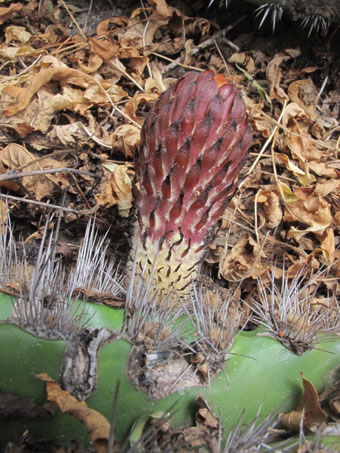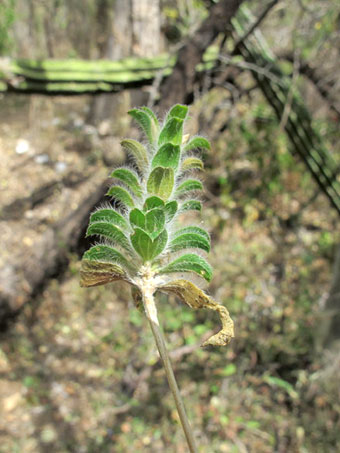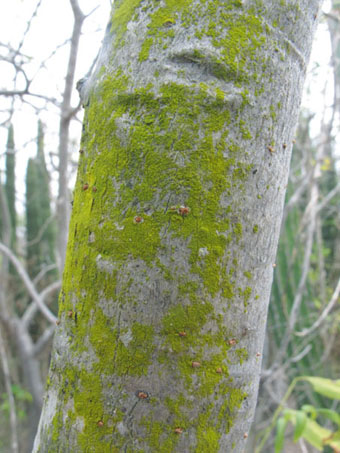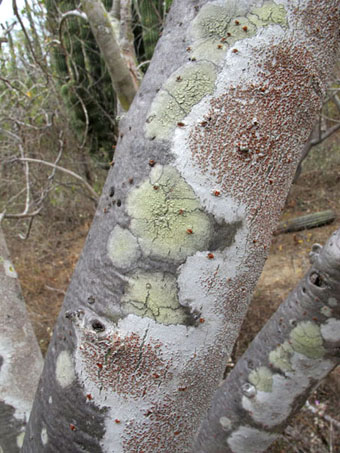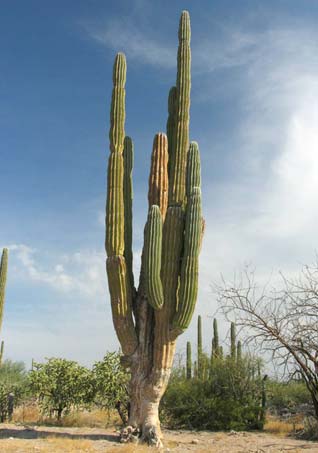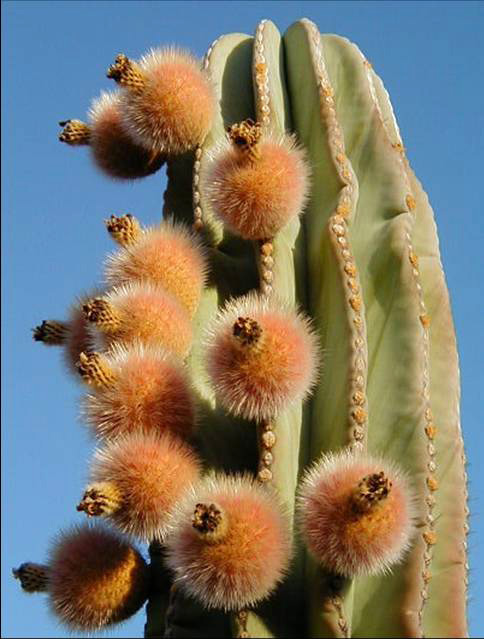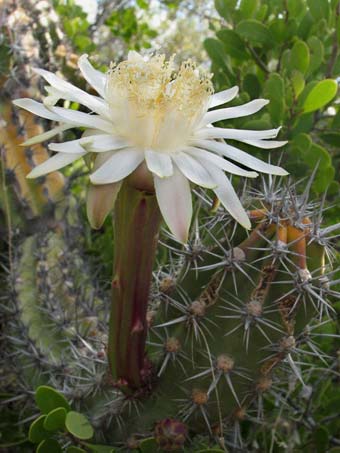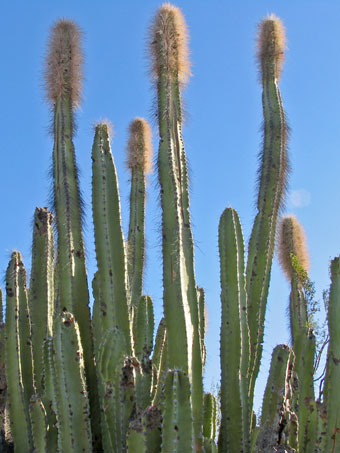
This section contains entries written for the UC BEE, the monthly newsletter for volunteers and staff
of the UC Berkeley Botanical Garden, about our botanizing in Baja California, and starting in October, 2012.
Click on any photo for a larger image.
BEE MAY 2015
La Paz, March 3, 2015 - El Santuario de los Cactus (Cactus Sanctuary)
This month, we had the opportunity to revisit the Sanctuary to see how it fared from the passage of Hurricane Odile last September. It was looking very ragged, indeed and could really use a few dozen volunteers to help clean it up. Any takers out there? Read more about the Sanctuary from our visit last year.
Odile was a Category 3 hurricane when it hit Cabo San Lucas head on and it was still very strong as it passed northward over Todos Santos, the Sanctuary and La Paz. It tracked right up the middle of the peninsula, hitting Loreto, Mulegé and San Ignacio before crossing over the Gulf near Bahía de los Ángeles and the Sonoran coast.
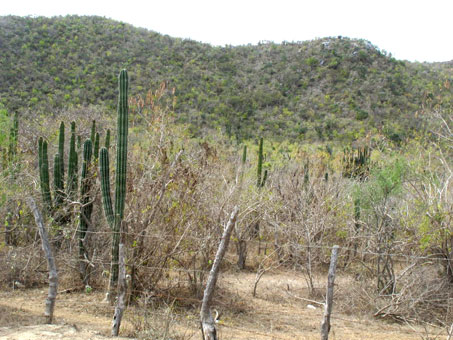
The Sanctuary is located on the edge of the low arid tropical forest, which was still showing the effects of all the rain from Odile. The columnar cacti on the left are Cardón Barbón (Pachycereus pecten-aboriginum), common in the Cape Region.
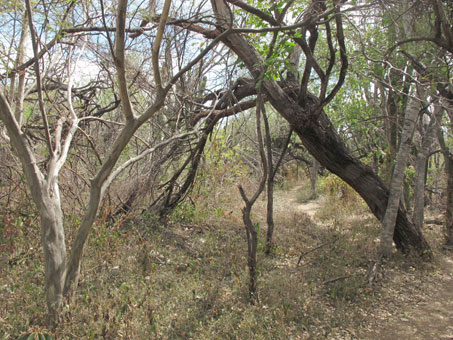
Inside the fenced area of the Sanctuary.
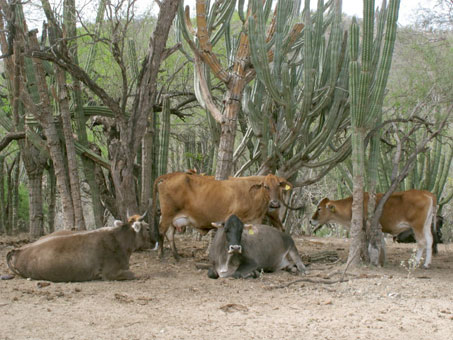
If the Sanctuary weren't fenced, these bovines would munch everything in it to bare dirt in no time at all.
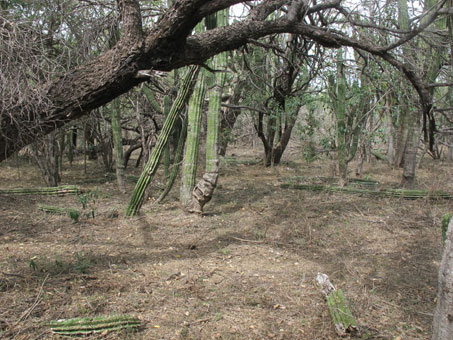
Right on the other side of the fence.
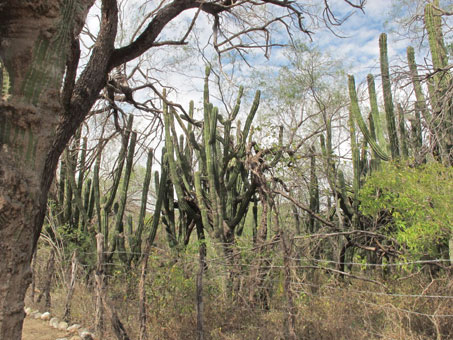
Dense scrub within the Sanctuary. As can be seen, the undergrowth was very dense and leafy.
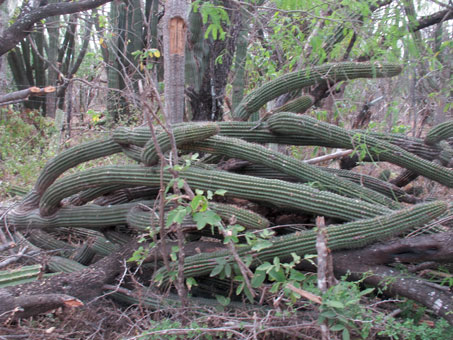
The damage to the giant cacti was visible immediately on entering the sanctuary. Organpipe Cactus / Pitahaya dulce (Stenocereus thurberi).
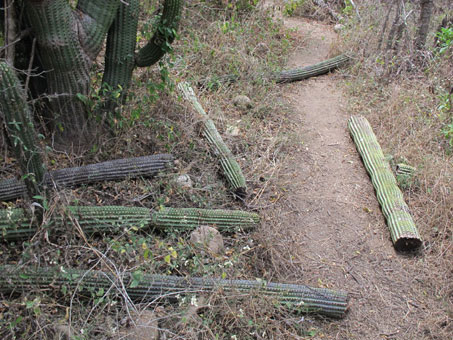
All throughout the sanctuary, cactus stems were strewn about, obviously snapped off by high winds from the hurricane.
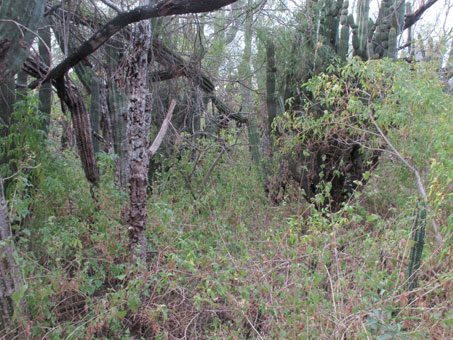
The undergrowth was much more dense and green than during last year´s visit.
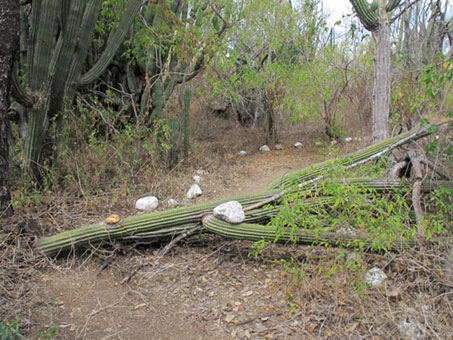
Here, a small Cardón Barbón (Pachycereus pecten-aboriginum) lies across the path.
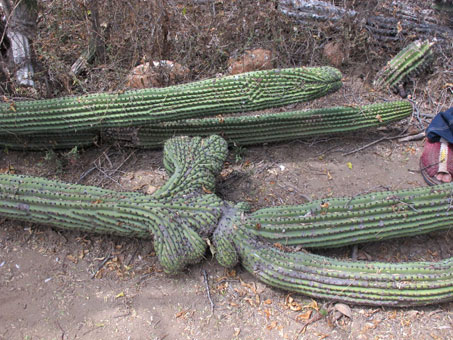
A beautiful crested Organpipe cactus (Stenocereus thurberi) has been toppled, roots and all by the wind. The caretaker plans to re-seat it.
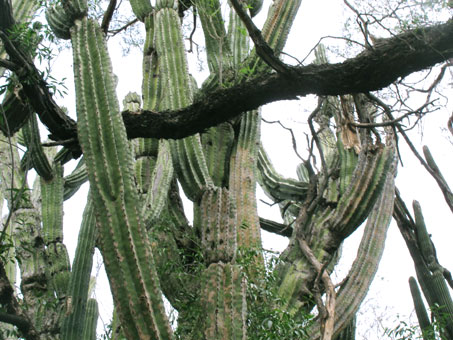
Giants like these were protected from the winds by nurse trees, mainly Mesquites, which are intertwined with the cacti. Cardón Barbón (Pachycereus pecten-aboriginum)
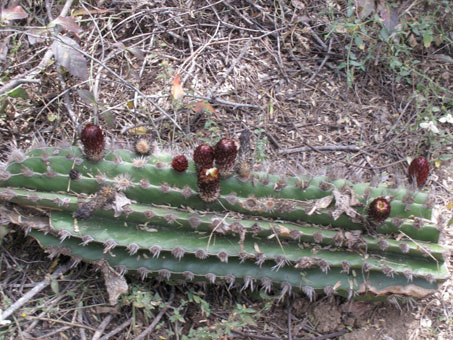
Last ditch effort from the broken stems: new buds.
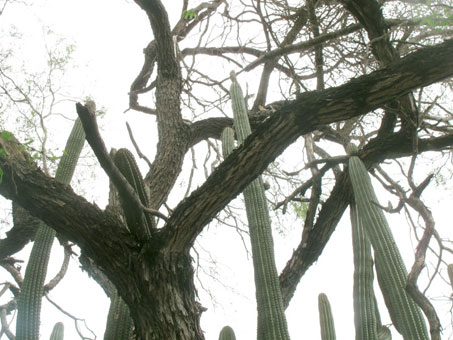
The nurse trees are vital for the health and longevity of the cacti in the tropical forest. Pitahaya dulce/Organpipe Cactus (Stenocereus thurberi).
Flower bud of Cardón Barbón.
Amidst the damage, there were many tiny annual and perennial wildflowers typical of the dry tropical forest, here and in other parts of the Americas. Acanthaceae seemed to be well represented among these flowers on our visit.
Olotillo (Tetramerium nervosum, Acanthaceae), a native perennial. The inflorescence is a spike with imbricate (overlapping) leafy bracts.
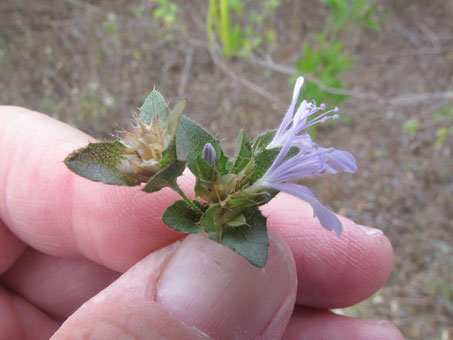
Loeselia ciliata (Polemoniaceae) is a slightly prickly annual or perennial herb of the undergrowth.
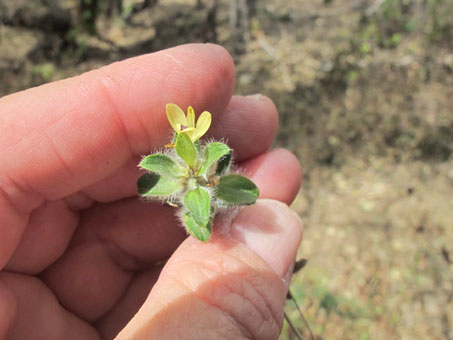
A tiny yellow flower arises from above each of the bracts in the spike of Olotillo.
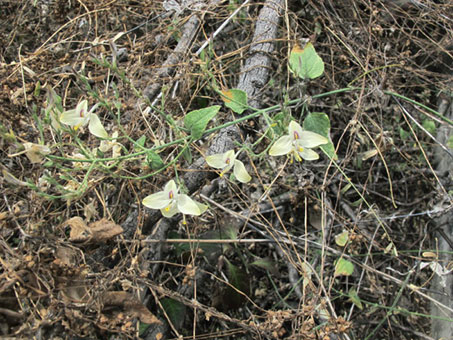
Rama toro / Arizona Wrightwort (Carlowrightia arizonica, another perennial in Acanthaceae). This was the most abundant wildflower of the sanctuary's understory. Flowers are cream to yellow-tinged and about 1 cm W.
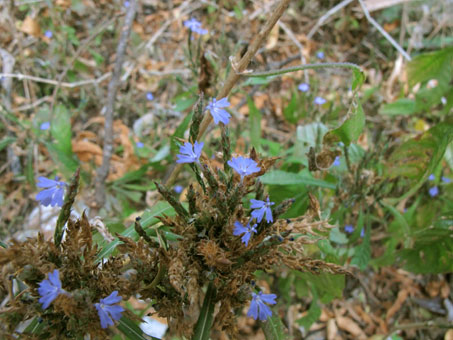
The angel-like flowers of Cordón de San Juan / Purple Scalystem (Elytraria imbricata, Acanthaceae) are tiny (5-6 mm W) and difficult to photograph in the low light of the forest. This was the second-most abundant of the flowers. The dark green pointy things are the spikey inflorescences, also with imbricate bracts.
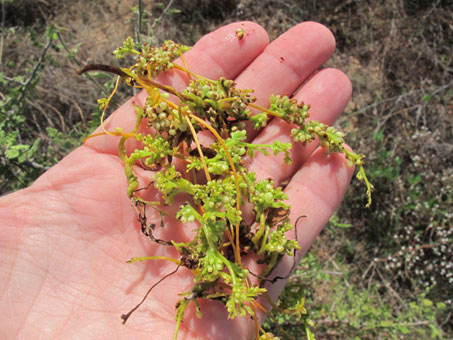
I saw this Dodder (Cuscuta sp., Convolvulaceae) at a different site about 20 km from the Sanctuary. It was on several different species in the scrub. This one is full of buds. Unfortunately I didn´t see open flowers.
What one lichen expert once told me is best described as a "dustose" lichen. Here, on Lomboy (Jatropha cinerea, Euphorbiaceae), it is like a smudge of lime green dust.
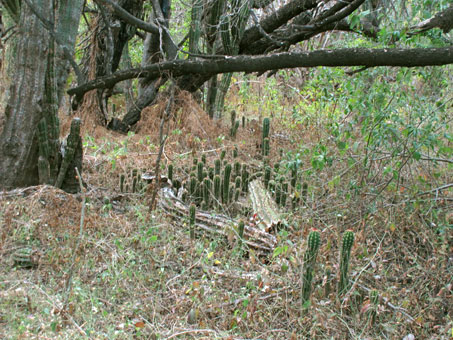
Cardoncitos (Cardón Barbón seedlings) growing under their nurse trees. Hopefully some day they will grow tall and large enough to replace their elders who have fallen alongside them.

The identification of this shrub had confounded me for several visits to the Sanctuary, but I just learned a helpful fact while visiting the herbarium in La Paz (see more on that below): Randia obcordata (Rutaceae) can have spines, or not. The first plants I saw had small, black fruit but no spines. This plant here had stout spines but no fruit. Other traits, such as habit, bark and leaves were the same. All is now clear.
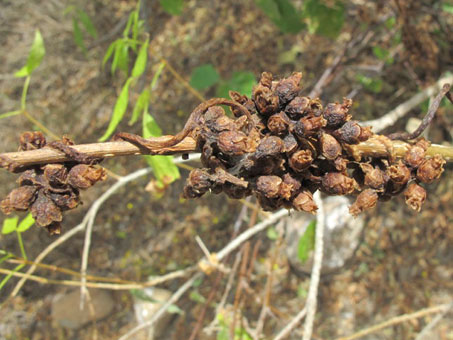
It is possible that this is the same species of Dodder (Cuscuta sp.), here on a Palo de Arco (Tecoma stans, Bignoniaceae) branch at the Sanctuary. It too grew on several types of plants and had large clusters of flowers.
Closeup view of some of the lichens on the bark of a Lomboy. Trees and shrubs everywhere were covered in a variety of colors.
March 4-6 - The Herbarium at CIBNOR (Centro de Investigaciones Biologicas del Noroeste), La Paz.
Something I have wanted to do for a number of years was to volunteer at the herbarium where I have been depositing my plant specimens since 2003. This year, things finally worked out and I was able to spend three mornings helping out with cacti are the largest species here, ranging in size from under a meter to 20 meters high and weighing many tons. Most have copious, edible fruit highly prized by animals and humans alike. The spines, while often large, somehow seem not so menacing as those of the chollas. Of course, I'd prefer not to be impaled by any of these beauties, but I find them somewhat easier to avoid than the sneaky chollas with their stems well-hidden within a larger, more interesting bush or sticking out slightly into the trail, as if waiting to snag a calf or knee.
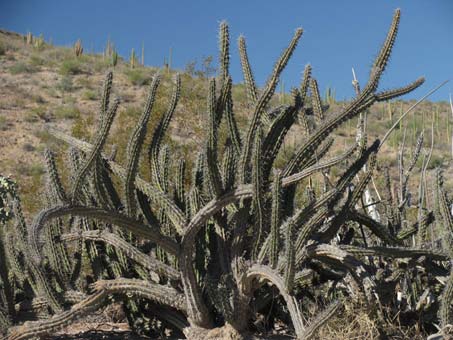
Pitahaya Agria or Galloping Cactus (Stenocereus gummosus) often forms widespread thickets. A stem that droops down onto the ground will take root and send up new vertical stems that in turn eventually droop down and take root. The galloping is very slo-mo...
The Cardón or Elephant Cactus (Pachycereus pringlei) has been called the world's largest cactus, reaching 20 meters. It loses its spines with age.
While very bristly, the fruit of Cardón is juicy and quite edible.
Large, tubular flowers of Pitahaya Agria or Galloping Cactus (Stenocereus gummosus) open in the late afternoon for night-time pollination.
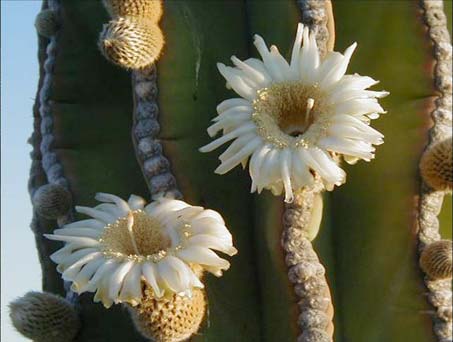
Flowers of the Cardón are large and pollinated by bats at night. Diurnal pollinators include bees, wasps and even white-winged doves.
Stems of Garambullo or Old Man Cactus (Lophocereus schottii); some are sexually mature and have developed a pseudocephalum from within which flowers will arise.
Well, that’s it for this series. I hope that it has been informative. Perhaps the most important take-away will be that the plants of the Baja California peninsula are many and diverse. You’ve seen that they range from tiny annual parasites growing on other tiny annual plants to the world´s largest arborescent cactus. You’ve also learned about the many different types of mechanisms that have allowed them to adapt and thrive over a broad range of habitats and environmental conditions. Hopefully, you will be fortunate to see these plants up close and personal some day. Just remember to look before you sit!
Until next month, hasta la próxima…
Debra Valov—Curatorial volunteer















